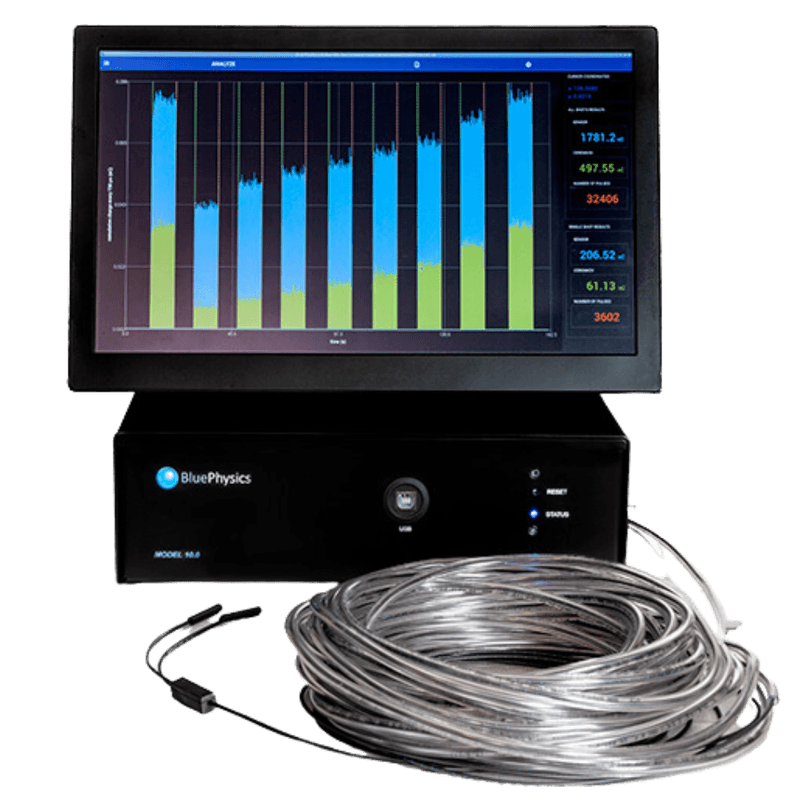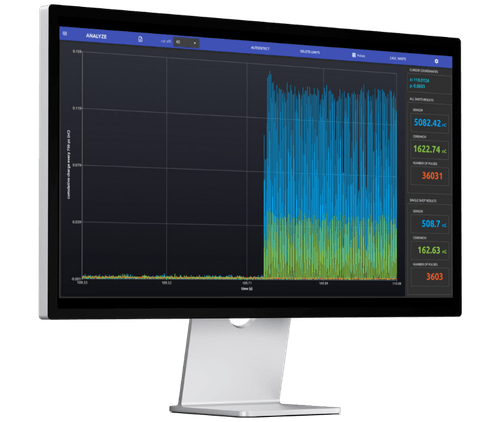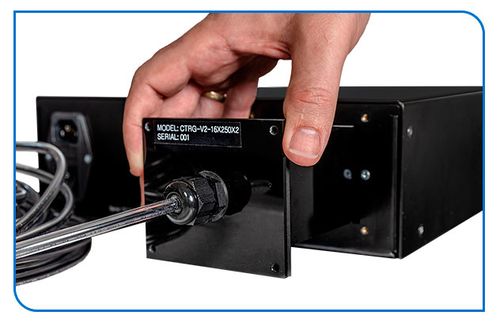Blue Physics Model 11
The Blue Physics Model 11 is a scintillation detector system designed for radiation detection. It is used to measure dose delivery information for each pulse. The system includes a plastic scintillation detector (PSD) connected to an interchangeable cartridge via two transport optical fibers, the acquisition unit, and a DELL laptop with BlueSoft software.
The PSD (Plastic Scintillation Detector): PSDs have a cylindrical shape with a diameter and length of 1 mm, giving them a sensitivity volume of 0.785 mm3. The scintillator features a polystyrene core with acrylic cladding. It contains a blend of fluorescent dopants chosen to create the desired scintillation effect. When a pulse of radiation interacts with the scintillator, it generates visible light. The intensity of this light (representing the number of photons produced) is directly proportional to the amount of dose deposited in the detector by that pulse [1].
Optical Fiber Coupling: The PSD connects to one of the transport plastic optical fibers. This fiber has a Polymethyl-Methacrylate core and Fluorinated Polymer cladding. It has a 0.25 mm diameter and can have a length of up to 20 m, depending on the specific cartridge used for the application. A jacket and flexible plastic tube encase the fiber for protection from accidental damage. This fiber transports the light from the PSD to the removable cartridge located outside the radiation area.
The Removable Cartridge: The removable cartridge houses all the optical connections between the transport optical fiber and the transducer that converts the light signal from the PSD into an electrical current. It also has an electrical connector that easily attaches and detaches from the acquisition unit. This design allows users to connect and disconnect the cartridge from the acquisition unit without affecting delicate optical couplings.
The Acquisition Unit: The acquisition unit accumulates and integrates the electrical current from the cartridge into a capacitor over a designated “integration time”. At the end of this period, it reads the accumulated charge, transforms the analog signal into a digital signal using an Analog to Digital Converter (ADC), and sends the digital reading to the software.
The Blue Physics Software: The Blue Physics software displays the readings in real time and calculates the total charge accumulated delivery. It also provides tools to analyze the measured signals and calculate the relative and absolute dose detected by the PSD.
Features:
1mm x 1mm cylindrical detector encased in a Real-time pulse plotting for immediate visual feedback.Sampling rate: 700 µs.Supports both conventional LINAC (up to 4 detectors) and Proton/Heavy Ion therapy (up to 8 detectors).Blue Physics specializes in customized solutions, including tailored detector arrays or expanded detector configurations upon request.
Benefits:
Provides precise dose delivery information for each pulse.
Enables real-time monitoring of dose delivery.
Improves accuracy of radiation therapy treatments.
Reduces the risk of errors in dose delivery.
Can be customized to meet the specific needs of each user.
In addition to the features of Blue Physics Model 11, here are some of the features and benefits of scintillation detectors in general:
- Sub-millimeter size: Making them ideal for small fields.
- Energy independence: Including multiple modalities >100keV.
- Angular independence: Including parallel and perpendicular orientations.
- High dose rate linearity: Ensuring accurate measurements at high dose rates.
- Water-equivalent material: Meaning they do not perturb the radiation field.
- Real-time dosimetry: Allowing for instant dose measurements for dynamic procedures.
- Flexible probe design: With high-performance optical fiber construction.
- Robust stem calibration: For complete subtraction of the stem components.
- Robust to radiation damages: For a long lifespan.
- Low dependence on temperature: For consistent performance in a variety of environments.


Model 11 supports cartridges with 1, 2, 4, 7 or 8 PSD’s. Those PSD’s can be arranged in several ways, for example:
1 x single PSD encapsulated in plastic replica of a Semiflex ion chamber to facilitate its position in a water tank or solid water phantom.
1 x single PSD encapsulated in a ‘minimum casting’ insert. This insert has minimum material around the sensor but still has a distal part with the same measurements of a Semiflex ion chamber to facilitate its positioning in a water tank or solid water phantom.
2 x PSD’s encapsulated in either of the previous insert. This can be used to use one sensor for scanning and the other one as a reference.
4 x PSD’s separated and encapsulated in either of the previous insert for the user to place them at 4 different positions either in a water tank or solid water phantom.
7 x PSD’s sensors encapsulated in a customized insert for RT-Safe head and neck phantom. The sensors will be distributed in strategic points for a rapid QA of Radiosurgery treatments.
8 x PSD’s sensors separated and encapsulated in any of the previous inserts to be placed in 8 different positions of a water tank or solid water phantom.


